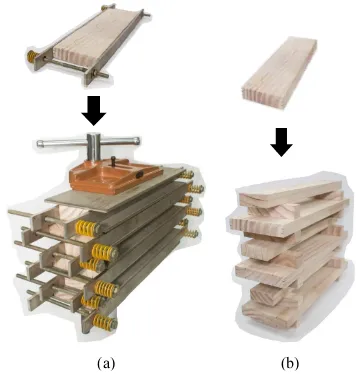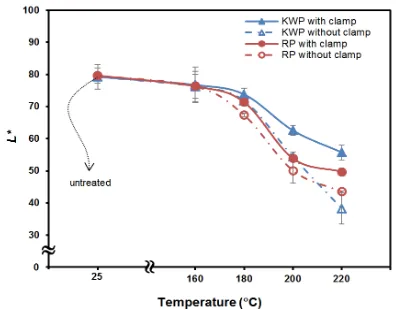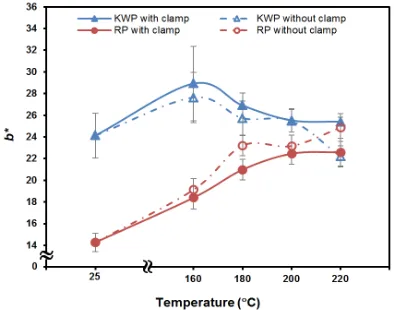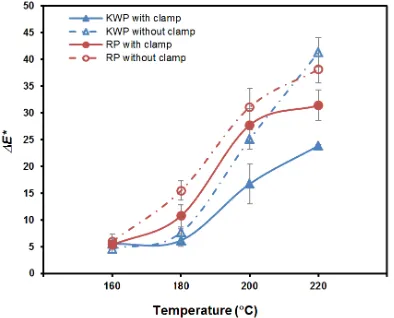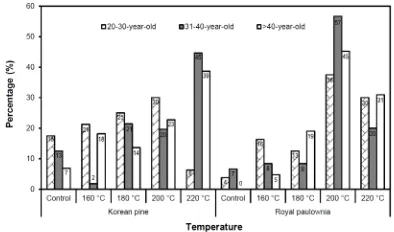1. INTRODUCTION
Color is one of the most important aesthetic aspects of wooden products. Wood color can be
naturally or artificially modified. Natural
mod-ification or color degradation of wood can be occurred due to the aging of wood, which is
defined as the irreversible change of physical,
Original Article
Color Change and Consumer Preferences towards Color of
Heat-Treated Korean White Pine and Royal Paulownia Woods
1Wahyu Hidayat2,3⋅Yue Qi2,4⋅Jae Hyuk Jang2,5⋅Byung Ho Park6⋅
Irwan Sukri Banuwa3⋅Fauzi Febrianto7⋅Nam Hun Kim2,†
ABSTRACT
Heat treatment of wood is an attractive alternative environmentally-friendly treatment to add value of less val-uable woods by improving color, dimensional stability, and natural durability. To improve the color properties of Korean white pine (Pinus koraiensis) and royal paulownia (Pauwlonia tomentosa), we treated the woods at 160℃, 180℃, 200℃, and 220℃ for 2 hours. Color change after heat treatment was evaluated using the
CIE-Lab color system and survey was conducted to determine the consumer preferences towards color of heat-treated wood. Lightness (L*) decreased with increasing temperature and the higher degree of change was
obtained in royal paulownia. The red/green chromaticity (a*) in both wood decreased after heat treatment at
160℃, and constantly increased after heat treatment at 180℃ to 220℃. Yellow/blue chromaticity (b*) in Korean
white pine tended to increase after heat treatment at 160℃, then decreased gradually afterwards. In royal pau-lownia, b* values linearly increased with increasing temperature. Overall color change (ΔE*) increased with in-creasing temperature with higher degree obtained in royal paulownia. Samples with the clamps in both wood species showed lower degree of the change in L*, a*, b and ΔE*. The results of the consumer preferences test showed that the darker colors of heat-treated woods were more preferred by consumers compared to the lighter colors of untreated woods. Consequently, heat treatment could enhance the color properties of Korean white pine and royal paulownia woods for value added products.
Keywords : clamping, color change, CIE-Lab color system, consumer preference, heat treatment
1Date Received February 24, 2017, Date Accepted March 6, 2017
2College of Forest and Environmental Sciences, Kangwon National University, Chuncheon 24341, Republic of Korea 3Department of Forestry, Faculty of Agriculture, Lampung University, Bandar Lampung, 35145, Indonesia
4Research Institute of Wood Industry, Chinese Academy of Forestry, Beijing 100091, China
5Department of Forest Products, National Institute of Forest Science, Seoul 02455, Republic of Korea 6College of Design and Sports, Kangwon National University, Samchoek 25913, Republic of Korea 7Department of Forest Products, Faculty of Forestry, Bogor Agricultural University, Indonesia †
chemical, and mechanical properties of wood
during extended storage or usage which may
occur due to climate, environment conditions,
and wood-destroying organisms such as insects, fungi, bacteria, and marine borers
(Sandoval-Torres et al., 2010; Kránitz et al.,
2016). Artificial modifications of wood color have been widely applied, but mostly toxic
chemical staining was used.
The aging of wood can be accelerated by ar-tificial aging methods that simulate the
con-ditions of outdoor weathering or indoor
photo-degradation processes (Pandey and Vuorinen,
2008; Park et al., 2016). An
environ-mentally-benign technology that has been used
as an accelerated wood aging method to modify
wood color is heat treatment of wood (Mitsui et al., 2001; Ganne-Chédeville et al., 2012). Heat
treatment induces color changes in wood,
espe-cially darkening (Bekhta and Niemz, 2003). In comparison to wood staining, the color change
by heat treatment takes place not only on the
surface but in the whole wood including the
in-ner parts with no toxic chemical used during the process (Esteves and Pereira, 2009; Kranitz
et al., 2016).
The light color of Korean white pine (Pinus koraiensis) and royal paulownia (Pauwlonia
to-mentosa) can be altered by heat treatment into
a darker color similar to highly-valuable woods
such as ebony and teak, which is an aesthetical advantage for some applications (Mitsui et al.,
2001; Bekhta and Niemz, 2003). In addition,
heat treatment can grade up the wood proper-ties, particularly the dimensional stability
(Chang et al., 2012; Hwang et al., 2015; Kim, 2016) and decay resistance (Kamdem and Pizzi,
2002; Hakkou et al., 2006).
Heat treatment can cause both desirable and undesirable color change defending on the
proc-ess conditions such as treatment temperature,
duration, and furnace atmosphere conditions (Sundqvist, 2002; Bekhta and Niemz, 2003; Lee
et al., 2015; Won et al., 2015; Kim, 2016). In
addition, our previous studies with high density
wood as okan (Cylicodiscus gabunensis)
showed that the application of mechanical
re-straint also affected the intensity of color
change after heat treatment and contributed pos-itive effects in preventing drying defects and
minimizing strength reduction (Hidayat et al.,
2015; Hidayat et al., 2016). In this study, we applied the mechanical restraint during heat
treatment of low density woods as Korean
white pine and royal paulownia. Heat treatment
was performed under different temperatures to obtain good color appearance and to avoid
un-desirable color change. To determine optimum
temperature resulted on the desirable color change of the wood, we also studied the
con-sumer preferences towards color of the
heat-treated woods. The results could provide
valuable information to increase added value of such wood species.
2. MATERIALS and METHODS
2.1. Materials
to-mentosa) were prepared for heat treatment.
Both woods have light color. Korean white pine
has light brown color in its heartwood and pale
yellow to nearly white sapwood, while royal paulownia has pale white sapwood which is not
clearly demarcated from its heartwood. The
air-dried densities were 0.43 g/cm3 and 0.27 g/cm3 for Korean white pine and royal
pau-lownia, respectively. The equilibrium moisture
content of Korean white pine and royal pau-lownia were about 8.69% and 7.68%,
respectively. Board samples were prepared with
the dimensions of 300 mm (length) × 90 mm
(width) × 20 mm (thickness). Before and after heat treatment, the surfaces of the boards were
sanded prior to color measurement.
2.2. Methods
2.2.1. Heat treatment
During heat treatment, the boards were
stacked with the clamps (Fig. 1a), using similar
method described in previous paper (Hidayat et al., 2016). The boards were also stacked
with-out the clamps for comparison (Fig. 1b). Heat
treatment was initiated at room temperature and then rose to the target peak temperatures of
160℃, 180℃, 200℃, and 220℃ with a heating
rate of 2℃/min. The target temperatures were maintained for 2 hours and in the final stage of
the heat treatment process, the oven chamber
was allowed to cool naturally until they reached
30℃. Then, the boards were taken out and sta-bilized at room temperature and relative
humid-ity of 65% for 2 weeks until further testing.
2.2.2. Color evaluation
The colorimetric evaluation was performed
using the CIE-Lab system (Esteves et al.,
2008). The CIE-Lab system is characterized by three color parameters as L*
, a*
, b*
. The L*
axis
represents lightness with the maximum value of
100 (white) and minimum value of 0 (black).
The a* axis represents red/green chromaticity with the positive values are in the red direction
(+a*) and negative values are in the green
di-rection (-a*). The b* axis represents yellow/blue chromaticity with the positive values are in the
yellow direction (+b*) and negative values are
in the blue direction (-b*).
For each sample, three measurement points
were marked on the board surface. The
meas-urements were taken both before and after heat
treatment with a chromameter (CR-400, Konica Minolta Inc., Tokyo, Japan). The chromameter
used illuminant C light source and an observed
(a) (b)
angle of 2°. Prior to the measurement, the
chromameter was calibrated with a white plate
(Y = 93.6, x = 0.3134, y = 0.3194). The
dif-ferences in lightness (ΔL*), red/green chroma-ticity (Δa*), and yellow/blue chromaticity (Δb*)
and the overall color change (ΔE*) were
cal-culated using the following equations,
ΔL* = La* - Lb* (1)
chromaticity, and yellow/blue chromaticity be-fore heat treatment; La
*
ness, red/green chromaticity, and yellow/blue
chromaticity after heat treatment; ΔL*, Δa*,
Δb*, and ΔE* represent the changes in
light-ness, red/green chromaticity, yellow/blue
chro-maticity, and the overall color, respectively.
The values of color changes (ΔE*) were
then used to define the levels of perceived
dif-ference in color (Cui et al., 2004; Valverde and
Moya, 2014). ΔE* between 0 to 0.5 is defined as negligible, between 0.5 to 1.5 is slightly
per-ceivable, between 1.5 to 3.0 is noticeable,
be-tween 3.0 to 6.0 is appreciable, bebe-tween 6.0 to 12.0 is very appreciable, and more than 12.0 is
totally changed.
2.2.3. Color preferences survey
Public survey was conducted to determine preferences of consumers associated with wood
color for flooring application. Accidental
sam-pling method was used by choosing the
re-spondents who were readily available and
wish-ed to participate for the survey. Survey was
performed in Kangwon National University, Republic of Korea. Two poster sets were
pre-pared, one set using Korean white pine wood
and another set using royal paulownia wood. Untreated sample and samples after heat
treat-ment with the clamps at 160℃, 180℃, 200℃,
and 220℃ from each wood species were
at-tached on the posters.
Respondents were asked to choose his/her
preferred color from each poster set by putting
a color sticker (according to the sex and age of the respondent). The total of 182 respondents
participated in the survey, consists of 100 male
and 82 female respondents. The respondent classification and the associated sticker
accord-ing to their age range and sex are as follow:
- Age between 20-30-year-old, consisted of 52 male respondents and 28 female respondents.
- Age between 31-40-year-old, consisted of 38
male respondents and 22 female respondents.
- Age above 40-year-old, consisted of 10 male respondents and 32 female respondents.
3. RESULTS and DISCUSSION
3.1. Color changes
The appearances of Korean white pine and
royal paulownia boards before and after heat
treatment are shown in Fig. 2 and the results of color measurements, i.e. the changes of
yel-low/blue chromaticity (b*) values after heat
treatment at 160℃, 180℃, 200℃, and 220℃
for 2 hours are presented in Fig. 3 to Fig. 5. The results showed that the untreated boards
of Korean white pine showed similar L* values
to royal paulownia, but the a* and b* values of Korean white pine were higher. In both Korean
white pine and royal paulownia boards, with
and without the clamps, L* values decreased slightly after heat treatment at 160℃ and 180℃,
and decreased remarkably after heat treatment
at 200℃ and 220℃ (Fig. 3). Samples with the
clamps showed lower L* decreases than without the clamps. The a* values in both woods
de-creased after heat treatment at 160℃, and
con-stantly increased after heat treatment at 180℃ to 220℃ (Fig. 4). The results of L* values were
similar to the results obtained in okan wood,
showing a decrease of L* values with increased temperatures, but okan wood showed no
sig-nificant changes in a* values after heat
treat-ment (Hidayat et al., 2015).
The b* values after heat treatment showed
different responses between in Korean white
pine and royal paulownia (Fig. 5). In Korean white pine, b* values tend to increase after heat
treatment at 160℃, then decreased gradually
afterwards. In royal paulownia, b* values line-arly increased with increasing temperature.
Control 160℃ 180℃ 200℃ 220℃
Korean white pine
Control 160℃ 180℃ 200℃ 220℃
Royal paulownia
Fig. 2. Colors of Korean white pine and royal paulownia woods before and after heat treatment with the clamps at different temperatures.
Samples with the clamps in Korean white pine had higher b* values than without the clamps,
while samples with the clamps in royal
pau-lownia had lower b* values than without the clamps.
The overall color change (ΔE*) increased
with an increase in temperature (Fig. 6). The
most visually obvious change after heat treat-ment was the reduction in lightness (L*) or the
darkening of the woods (Fig. 2). Cui et al.
(2004) also reported that the lightness change (ΔL*) was the most important parameter
affect-ing the color change. Salca et al. (2016) added
that the reduction in L* values was related to the degradation of hemicelluloses during heat
treatment.
The results revealed that Korean white pine
had lower ΔE* than royal paulownia, with the exception of Korean white pine sample without
the clamps heat-treated at 220℃ (Fig. 6). The
results were in a good agreement with
Sandoval-Torres et al. (2010), who stated that
hardwoods generally discolor at lower temper-ature than softwoods. The ΔE* in both woods
were similar after heat treatment at 160℃. In
Korean white pine, the ΔE* increased very slightly with increasing temperature to 180℃,
then drastically increased after heat treatment at
200℃ and 220℃. Overall results revealed that
colors of both Korean white pine and royal paulownia woods were totally changed (ΔE*=
> 12.0) after heat treatment at 200℃, with the
detail levels of perceived differences in color are presented in Table 1. This results are in a
good agreement with the findings of Bekhta
and Niemz (2003), who observed that the color of wood changed drastically after heat treatment
at 200℃. Hidayat et al. (2015) reported that
temperatures ranging from 180℃ to 200℃ are
significantly critical to the change in color of heat-treated okan wood.
Fig. 6 clearly shows that the samples with Fig. 4. Effect of temperature and clamping method
on the change of a* value (KWP = Korean white pine; RP = royal paulownia).
the clamps exhibited a lower magnitude of ΔE*
than the samples without the clamps. Hidayat et al. (2016) stated that clamping during heat
treatment protected the wood sample surfaces
(radial and tangential surfaces) from direct con-tact with the heated air, and allowed only the
cross section surfaces to be exposed. This may
have resulted in a lower oxidation of wood
components than for the samples without the
clamps.
3.2. Consumer preferences towards colors of heat-treated woods
Information about consumer preferences
to-wards wood products is one of the important
considerations to several decision makers in the
forest sector (Hoibo and Nyrud, 2010). The study that reveals consumer preferences could
provide useful information for marketing and
manufacturing of wood products, and also pro-vide information of relevance to designers and
decision makers involved in building design and
construction processes. Color is an attribute of visual perception, which is one of the important
factors that influence customers when choosing
wood products (Sandoval-Torres, 2010).
In this study, the overall results of color pref-erences test revealed that respondents expressed
a stronger preference for the darker color of
Species Temp.
(℃)
ΔE* Level
With the clamps Without the clamps
Korean white pine
160 Appreciable Appreciable
180 Very appreciable Very appreciable
200 Totally changed Totally changed
220 Totally changed Totally changed
Royal paulownia
160 Appreciable Very appreciable
180 Very appreciable Totally changed
200 Totally changed Totally changed
220 Totally changed Totally changed
* According to the classification of the level color change by Cui et al. (2004) and Valverde and Moya (2014): (1) negligible: ΔE* between 0 to 0.5; (2) slightly perceivable: ΔE* between 0.5 to 1.5; (3) noticeable: ΔE* between 1.5 to 3.0; (4) appreciable: ΔE* between 3.0 to 6.0; (5) very appreciable: ΔE* between 6.0 to 12.0; and (6) totally changed: ΔE* more than 12.0.
Table 1. The levels of perceived difference in color after heat treatment
heat-treated woods than the original color
Korean white pine and royal paulownia woods (Fig. 7). In Korean white pine, the colors of
heat-treated wood at 200℃ and 220℃ were the
most preferred color according to the choice of
25% and 26% of the total respondents. In royal paulownia, the most preferred color was the
color of heat-treated wood at 200℃ according
to the preference of 46% of the total respondents. The overall results were in a good
agreement with previous report by Cao et al.
(2012), they stated that dark brown colors are currently in demand and widely appreciated by
customers in the flooring, furniture, and
deco-ration markets.
The results of consumer preferences test ac-cording to sex and age also showed similar
trends with the overall results, showing
re-spondents more appreciated heat-treated woods having darker colors to be used for flooring and
furniture applications, particularly woods treated
at 200℃ and 200℃ (Fig. 8 and Fig. 9). In Korean white pine, most male respondents
preferred darkest color or wood treated at 220℃
(28%), while most female respondents preferred
the color of wood treated at 200℃ (32%).
According to age, respondents at younger age
range (20-30-year-old) mostly preferred Korean
white pine wood treated at 200℃ and the re-spondents at older age range (30-40 and
>40-year-old) preferred more darker wood
treat-ed 220℃. In royal paulownia, the results were more consistent, showing woods treated at
200℃ as the most appreciated color according
to sex and age ranges. The results of in-depth
interview with representative respondents re-vealed that they preferred darker colors of
heat-treated royal paulownia. However, the col-Fig. 7. Consumer preferences towards color of
Korean white pine and royal paulownia woods.
Fig. 8. Consumer preferences by sex towards color of Korean white pine and royal paulownia woods.
or of wood treated at 220℃ almost wore off
the natural texture of the wood.
4. CONCLUSION
Heat treatment affected the color parameters
of Korean white pine and royal paulownia
woods. Lightness (L*) decreased with increasing temperatures and remarkable decreased obtained
after heat treatment at 200℃ and 220℃.
Korean white pine showed lower L* decreases than royal paulownia. The red/green
chroma-ticity (a*) in both woods decreased after heat
treatment at 160℃, and constantly increased
after heat treatment at 180℃ to 220℃.
Yellow/blue chromaticity (b*) in Korean white
pine tended to increase after heat treatment at
160℃, then decreased gradually afterwards. In royal paulownia, b* values linearly increased
with increasing temperature. Overall color
change (ΔE*) increased with increasing temper-ature with higher degree obtained in royal
paulownia. Clamping lowered the degree of the
changes in L*, a*, b and ΔE* in both woods. The results of color preferences test revealed
that consumers preferred the darker colors of
heat-treated woods than the original color
Korean white pine and royal paulownia woods, particularly at 200℃.
ACKNOWLEDGEMENT
This work was performed with the support of
research grant provided by National Research
Foundation of Korea (NRF-2016R1D1A1B01008339).
REFERENCES
Bekhta, P., Niemz, P. 2003. Effect of high
temper-ature on the change in colour, dimensional
sta-bility and mechanical properties of spruce wood.
Holzfoschung. 57(5): 539∼546.
Cao, Y., Jiang, J., Lu, J., Huang, R., Jiang, J., Wu,
Y. 2012. Color change of chinese fir through
steam-heat treatment. BioResources 7(3): 2809∼
2819.
Chang, Y.S., Han, Y.J., Eom, C.D., Park, J.S., Park,
M.J., Choi, I.G., Yeo, H.M. 2012. Analysis of
factors affecting the hygroscopic performance of
thermally treated Pinus koraiensis wood. Journal
of the Korean Wood Science and Technology
40(1): 10∼18.
Cui, W., Kamdem, D.P., Rypstra, T. 2004. Diffuse
reflectance infrared Fourier transform
spectro-scopy (DRIFT) and color changes of artificial
weathered wood. Wood and Fiber Science 36(3):
291∼301.
Esteves, B.M., Domingos, I., Pereira, H. 2008. Pine
modification by heat treatment in air.
BioResources 3(1): 142∼154.
Esteves, B.M., Pereira, H. 2009. Wood modification
by heat treatment: A review. BioResources 4(1):
340∼404.
Ganne-Chedeville, C., Jaaskelainen, A.S., Froidevaux,
J., Hughes, M., Navi, P. 2012. Natural and artifi
cial ageing of spruce wood as observed by
FTIR-ATR and UVRR spectroscopy.
Holzforschung 66(2): 163∼170.
Hakkou, M., Petrissans, M., Gerardin, P., Zoulalian,
A. 2006. Investigations of the reasons for fungal
durability of heat-treated beech wood. Polymer
Degradation and Stability 91(2): 393∼397.
Hidayat, W., Jang, J.H., Park, S.H., Qi, Y.,
Febrianto, F., Lee, S.H., Kim, N.H. 2015. Effect
treat-ment on physical and mechanical properties of
okan (Cylicodiscus gabunensis [Taub.] Harms)
wood. BioResources 10(4): 6961∼6974.
Hidayat, W., Qi, Y., Jang, J.H., Febrianto, F., Lee,
S.H., Kim, N.H. 2016. Effect of treatment
dura-tion and clamping on the properties of
heat-treated okan wood. BioResources 11(4):
10070∼10086.
Hoibo, O., Nyrud, A.Q. 2010. Consumer perception
of wood surfaces: the relationship between stated
preferences and visual homogeneity. Journal of
Wood Science 56(4): 276∼283.
Hwang, S.W., Cho, B.G., Lee, W.H. 2015. Hardness
and dimensional stability of thermally
com-pressed domestic Korean pine. Journal of the
Korean Wood Science and Technology 43(1): 68
∼75.
Kamdem, D.P., Pizzi, A., Jermammaud, A. 2002.
Durability of heat-treated wood. Holz als
Roh-und Werkstoff 60: 1∼6.
Kim, Y.S. 2016. Research trend of the heat-treatment
of wood for improvement of dimensional
stabil-ity and resistance to biological degradation.
Journal of the Korean Wood Science and
Technology 44(3): 457∼476.
Kranitz, K., Sonderegger, W., Bues, C.T., Niemz, P.
2016. Effects of aging on wood: a literature
review. Wood Science and Technology, 50(1):
7∼22.
Lee, W.H., Lim, H.M., Kang, H.Y. 2015. The color
change of korean pine specimens oil-heat-treated
at 180 and 200℃. Journal of the Korean Wood
Science and Technology 43(4), 438∼445.
Mitsui, K., Takada, H., Sugiyama, M., Hasegawa, R.
2001. Changes in the properties of
light-irradi-ated wood with heat treatment: Part 1 Effect of
treatment conditions on the change in color.
Holzforschung 55(6): 601∼605.
Pandey, K.K., Vuorinen, T. 2008. Comparative study
of photodegradation of wood by a UV laser and
a xenon light source. Polymer Degradation and
Stability 93(12): 2138∼2146.
Park, S.H., Jang, J.H., Qi, Y., Hidayat, W., Hwang,
W.J., Febrianto, F., Kim, N.H. 2016. Color
change of major wood species planted in
Indonesia by ultraviolet radiation. Journal of the
Korean Wood Science and Technology 44(2):
172∼183.
Salca, E.A., Kobori, H., Inagaki, T., Kojima, Y.,
Suzuki, S. 2016. Effect of heat treatment on
col-our changes of black alder and beech veneers.
Journal of Wood Science 62(4): 297∼304.
Sandoval-Torres, S., Jomaa, W., Marc, F., Puiggali,
J.R. 2010. Causes of color changes in wood
dur-ing drydur-ing. Forest Studies in China 12(4): 167∼
175.
Sundqvist, B. 2002. Color response of Scots pine
(Pinus sylvestris), Norway spruce (Picea abies)
and birch (Betula pubescens) subjected to heat
treatment in capillary phase. Holz Roh-Werkst
60: 106∼114.
Valverde, J.C., Moya, R. 2014. Correlation and
mod-eling between color variation and quality of the
surface between accelerated and natural tropical
weathering in Acacia mangium, Cedrela odorata
and Tectona grandis wood with two coating.
Color Research and Application 39(5): 519∼529.
Won, K.R., Hong, N.E., Park, H.M., Moon, S.O.,
Byeon, H.S. 2015. Effects of heating temperature
and time on the mechanical properties of
heat-treated woods. Journal of the Korean Wood
